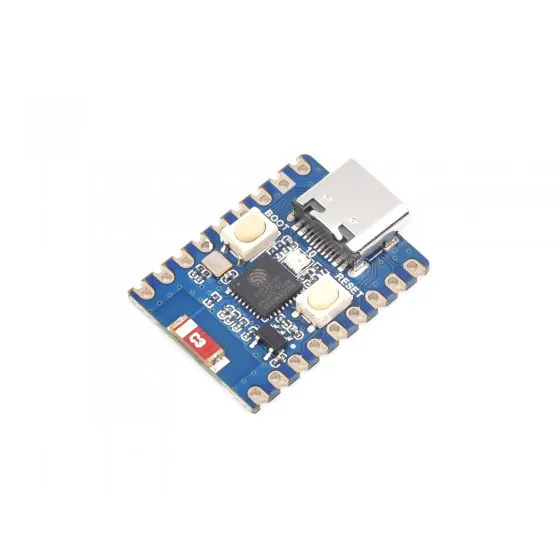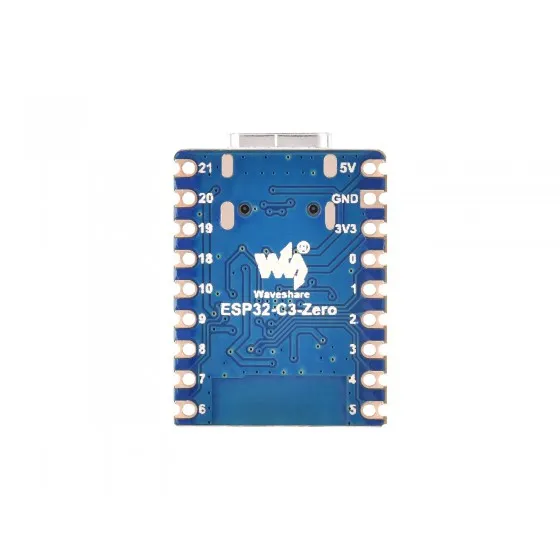
In the ever-evolving world of microcontrollers and the Internet of Things (IoT), the ESP32-C3 stands out as a compact yet powerful solution designed to deliver efficiency, connectivity, and innovation. Whether you're a hobbyist, a student, or a professional developer, the ESP32-C3 offers a unique blend of features that make it ideal for a wide array of applications.
In this post, we'll explore the ESP32-C3 in depth, covering its technical specifications, key features, advantages, and practical use cases. We’ll also reflect on personal experiences and offer insights into why this board is gaining popularity among makers and developers.
1.Introduction to ESP32-C3:
The ESP32-C3 is a cost-effective, low-power, RISC-V-based microcontroller developed by Espressif Systems. It is part of the popular ESP32 family, which has already made a significant mark in the world of IoT and embedded systems.
Unlike its predecessors (which were based on Tensilica Xtensa cores), the ESP32-C3 features a single-core 32-bit RISC-V processor. It supports Wi-Fi and Bluetooth Low Energy (BLE) 5.0, making it an excellent choice for wireless projects.
2.Technical Specifications:
Processor: 32-bit RISC-V single-core, up to 160 MHz

RAM: 400 KB SRAM
ROM: 384 KB ROM
Flash: Typically comes with 4MB Flash (configurable)
Connectivity: Wi-Fi 802.11 b/g/n, BLE 5.0
GPIOs: Up to 22 programmable GPIOs
Security: Secure boot, flash encryption, cryptographic hardware acceleration
Interfaces: SPI, I2C, UART, ADC, PWM, GPIO
USB: Native USB (OTG and Device Mode)
These specs may look modest on paper, but when combined with the RISC-V core and low power consumption, they open the door for efficient and secure embedded applications.
3.Key Features and Benefits:
RISC-V Architecture: The move to open-source RISC-V architecture is a strategic step. It offers transparency, community support, and eliminates licensing restrictions.
Wi-Fi and BLE 5.0: The inclusion of both wireless technologies allows for flexible connectivity options, essential for smart home, wearables, and industrial IoT.
Low Power Consumption: Suitable for battery-powered projects like sensors and trackers.
Robust Security: With features like secure boot and flash encryption, it meets the needs of modern IoT security requirements.
Compact Form Factor: Ideal for space-constrained applications.
Native USB Support: Eliminates the need for external USB-to-Serial chips, simplifying hardware design.
4.Getting Started with ESP32-C3:
Getting started with ESP32-C3 is straightforward. You can program it using familiar environments such as:
Arduino IDE
PlatformIO
ESP-IDF (Espressif IoT Development Framework)
No
Most beginner-friendly boards (like ESP32-C3 DevKitM-1 or NodeMCU-style variants) come with a USB-C connector, allowing easy programming and debugging.
After installing the necessary board packages and drivers, you can upload your first sketch in minutes. For example, the traditional "Blink" sketch can be adapted easily to test your GPIO pins.
5.Real-World Applications:
Thanks to its versatile features, the ESP32-C3 can be used in a wide variety of real-world applications:
Smart Home Devices: Control lights, fans, or sensors via Wi-Fi or BLE.
Wearables: Lightweight and low power make it suitable for fitness trackers.
Industrial Automation: Monitor machinery, log data, and send alerts wirelessly.
Remote Sensor Nodes: Its energy efficiency makes it great for long-term deployments.
USB Gadgets: Use native USB support to create HID devices like keyboards or mice.

6. Comparison with ESP8266 and Other ESP32 Boards:
While the ESP8266 remains a classic low-cost option, the ESP32-C3 brings significant improvements:
Feature ESP8266 ESP32-C3
Core 32-bit Xtensa 32-bit RISC-V
BLE No Yes (BLE 5.0)
Security Basic Secure Boot, Flash Encryption
USB No Native USB
Power Efficiency Moderate High
Compared to ESP32 (original dual-core variants), the C3 is less powerful in terms of performance but excels in power consumption, cost, and simplicity.
7. Challenges and Limitations:
No product is without limitations. Here are some areas where the ESP32-C3 may not be ideal:
Single Core: Less processing power for multi-threaded or high-performance applications.
Fewer GPIOs: Might not be enough for complex I/O-rich applications.
Limited RAM: May restrict larger applications or buffers.
Despite these, for most IoT projects, these limitations are manageable and outweighed by its benefits.
8. Personal Experience & Reflections:
As someone who enjoys tinkering with microcontrollers, I found the ESP32-C3 to be a refreshing change. I recently used it to build a Wi-Fi-controlled RC plane, where its small size, low power usage, and reliable Wi-Fi made it perfect for on-board control. The native USB helped a lot during development and debugging.
What stood out most was how easy it was to integrate with existing libraries in the Arduino ecosystem. The BLE 5.0 capabilities are also impressive; I’m currently experimenting with proximity-based control using a smartphone app.
9. Community and Ecosystem:
The ESP32-C3 has a growing community. Espressif’s documentation is detailed, and platforms like GitHub, Reddit, and the Arduino forum have numerous projects and support threads.
You can find example projects for:
1. Home automation
2. BLE Mesh networking
3.
USB HID devices
4. Battery-powered IoT sensors
10.Final Thoughts:
The ESP32-C3 might not be the most powerful microcontroller, but it excels in the areas that matter most for practical, modern IoT applications — connectivity, efficiency, security, and ease of use. Its adoption of the RISC-V architecture also signals a shift toward more open and collaborative development in the embedded world.
Whether you're building a small DIY gadget or a scalable IoT solution, the ESP32-C3 deserves a place on your workbench.
Have you used the ESP32-C3? Share your experience or project idea in the comments.let’s build and learn together